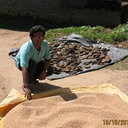Carbohydrate content and antioxidative potential of the seed of three edible indica rice (Oryza sativa L.) cultivars.
Keywords
Abstract
Rice (Oryza sativa L.) grains or seeds are known to lose much of their nutrient and antioxidant contents, following polishing. The current study was undertaken to evaluate and compare the carbohydrate content and antioxidant parameters in the unpolished and polished seeds of three edible indica rice cultivars, namely Swarna (SW), the most popular indica rice cultivar in India and aromatic or scented cultivars Gobindobhog (GB) and Pusa Basmati (PB). While both the sucrose and starch content was the maximum in PB seeds (both unpolished and polished), the amylose content was the highest in SW polished seeds. SW polished seeds were superior as compared to GB and PB cultivars in terms of total antioxidant capacity, DPPH radical scavenging and Fe(II) chelation potential, as well as the highest lipoxygenase (LOX) inhibition or H2O2 scavenging potential, probably due to the maximum accumulation of total phenolics and flavonoids, the two important antioxidants. The reducing power ability was, however, identical in both SW and GB polished seeds. The PB polished seeds were more potent in superoxide and hydroxyl scavenging, whereas GB in nitric oxide (NO) scavenging. The common observation noted after polishing of seeds was the reduction in the level of carbohydrates and antioxidant potential, though the extent of reduction varied in the three cultivars. The only exception was GB, where there was no alteration in NO scavenging potential even after polishing. Our study showed the better performance of SW polished seeds with respect to higher amylose content and majority of the tested parameters governing antioxidant capacity and radical scavenging potential, thus highlighting the greater dietary significance of SW over the other two cultivars.


